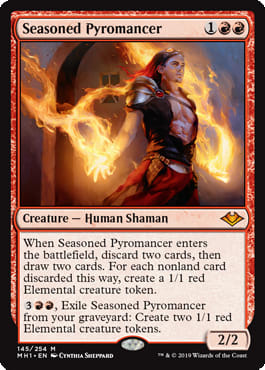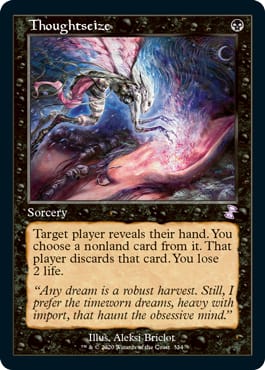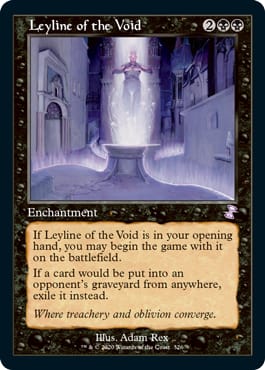The Magic: Arena format Historic will be fought over graveyards. With Brainstorm banned, the strongest card from Strixhaven's Mystical Archive is now Faithless Looting. The Red card will enable everything from Arclight Phoenix to Mizzix's Mastery to Priest of Fell Rites. The last will be released on August 26th as part of the massive Jumpstart: Historic Horizons. The influx of the set's creatures will balance at least in part the format's bias toward spells.
With the introduction of Serra's Emissary, we now have another potent creature to enable the format of Reanimator. Though these cards were printed in Modern Horizons II alongside Persist, in Historic they are complemented by another recursive spell in Unburial Rites. Instead of Archon of Cruelty we are free to summon from beyond the veil such illustrious legends as Elesh Norn, Grand Cenobite and Jin-Gitaxias, Core Augur, which were added in a recent Historic supplement. The cherry on top of this deathly sundae is the new Seasoned Pyromancer, a potent enabler. Turn three Seasoned Pyromancer, discarding Elesh Norn and Unburial Rites, means on turn four you can attack for ten.
In this article we will consider the cost of Historic Reanimator on Arena. We'll review the decklist and discuss sideboarding strategies against the most common graveyard hate.
The Cost of Digital
Though I am confident in Reanimation as a Historic archetype, I was less certain about how much it would cost. Magic: Arena hides the true price of decks, by design. I prefer to be clear-eyed about it. Earlier, I discovered it would take about $60 to buy into Slivers. That tier-two deck requires only eleven rares and a few mythics. Reanimator, however, weighs in at an intimidating thirty-three rares and fourteen mythics.
Reanimator Buys | Historic | AE Marling
That's not even counting the sideboard, which could benefit from as many as seven additional rares. I'll set those aside for now, as you could find cheaper options. You could also replace Elesh Norn, Grand Cenobite with less mythical finishers, such as Velomachus Lorehold or Zetalpa, Primal Dawn. You may already own some of the above cards. Or when opening packs for wildcards, you may high-roll into the cards you need. All else being equal, I suggest opening Ravnica Allegiance, as nine of our rares come from there. You cannot buy packs of Jumpstart: Historic Horizons, though if you've played it extensively in the queues you will have some of these cards. For the purposes of this calculation, I will assume you have to craft all the cards on the above list using wildcards.
Every thirty packs will give you roughly five rares and two mythics. That means you'll need 198 packs to find the rares and 210 packs to get the mythics. Forty-five packs costs 9,000 gems, which translates into $53. Multiplying it out, to buy Reanimator from scratch would cost about $247.
If this is your entry into Magic: Arena, you get a discount on your first gems buy. If you have been playing on this platform for a while, you may have an equivalent 210,000 gold, or the fourteen mythic wildcards ready to go.
Though buying these same cards in paper would cost more than twice as much, $247 still seems like a large amount for a digital game. After reading this article you'll have to decide if that's worth it to you. As for myself, I've always had an interest in Reanimator, having played it in Legacy and cosplayed often as Stitcher Geralf.

The Deck
If you decide to spend your gold to buy these costly components, it will likely be for the rush of reanimating such magnificent monstrosities as Jin-Gitaxias, Core Augur. You can do this as early as turn three, and therein lies your advantage over comparable graveyard-focused combo decks like Dragonstorm. That deck's win comes on turn four or five. Yours can be a turn faster, thanks to Priest of Fell Rites or a flashback Unburial Rites. While you won't win immediately, technically, many decks can't beat a resolved Elesh Norn, Grand Cenobite, and Serra's Emissary naming creatures will often shut out decks or reduce them to a handful of outs.
Reanimator | Historic | AE Marling
- Creatures (18)
- 3 Elesh Norn, Grand Cenobite
- 3 Jin-Gitaxias, Core Augur
- 4 Priest of Fell Rites
- 4 Seasoned Pyromancer
- 4 Serra's Emissary
- Sorceries (17)
- 1 Thrilling Discovery
- 2 Deafening Clarion
- 2 Late to Dinner
- 4 Faithless Looting
- 4 Thoughtseize
- 4 Unburial Rites
- Artifacts (1)
- 1 Portable Hole
- Lands (24)
- 3 Mountain
- 2 Plains
- 1 Sacred Foundry
- 2 Blood Crypt
- 4 Clifftop Retreat
- 4 Dragonskull Summit
- 4 Godless Shrine
- 4 Savai Triome
- Sideboard (15)
- 2 Archon of Emeria
- 3 Cling to Dust
- 1 Deafening Clarion
- 1 Deafening Silence
- 2 Inquisition of Kozilek
- 4 Rip Apart
- 2 Rotting Regisaur
The maindeck focuses on combo speed and redundancy. After Game 1, you will side out a few finishers and one or two Late to Dinner. Against aggressive decks, trim your copies of Jin-Gitaxias, Core Augur. Against control or combo decks, Elesh Norn, Grand Cenobite is not at her best.
Game-one gameplay is straightforward. My main piece of advice is to name "creature" with Serra's Emissary by default. Be aware that Unholy Heat can combine with another burn spell to kill your angel, but if that happens you may be able to reanimate again.
The Deafening Clarion cards do play an important role to punish fast creature decks. Believe it or not, I was losing to tribal Cats. Adorned Pouncer into King of the Pride is a fast clock. They then sideboarded in Rest in Peace and or Soul-Guide Lantern. You should expect a minimum of four pieces of graveyard hate from all your foes. Though these are hard cards to beat, you have many countermeasures, including the maindeck Portable Hole and Thoughtseize.
This card is played in Legacy Reanimator. Not only can it strip hate out of the opponent's hand but it can also discard your own finisher. The sideboard discard in Inquisition of Kozilek doesn't have the same flexibility. I prefer them over Duress because they can also hit Brazen Borrower, which can thwart your nefarious schemes.
Transformational Sideboarding
In a word, don't.
I've tried it across formats, and it's never realistic. As tempting as it is to avoid graveyard hate by changing your game plan, you end up outsmarting yourself. Whatever you think your plan B is, it won't be strong or fast enough. It's better to fight through graveyard hate or even hope your foe doesn't draw it.
For a while I tested this deck with only Mardu finishers, thinking that I could side in more interaction and control the game until I could hard cast my win cons. Well, it didn't work, not consistently. Though you will sometimes tap seven lands to cast your White creatures, you shouldn't fool yourself into thinking that or any other transformational sideboarding amounts to an actual plan. Instead, know your enemy and be ready to face their hate.
Versus Soul-Guide Lantern
This 1-drop artifact is the most common piece of interaction you should expect. It pairs well with Lurrus of the Dream-Den and can be played out of Izzet Phoenix. Assume most opponents will bring in four of it. The bad news is that it's hard to beat, especially if it exiles a critical piece out of your graveyard when it enters play.
The good news is that if your opponent holds it for that value, it is vulnerable to discard. I like sideboarding in the Inquisition of Kozilek. Thoughtseize can also remove it cleanly. Then try to combo before they can recur it with Lurrus.
Should your foe play Soul-Guide Lantern turn one, before you can get them to discard it, you can kill it with Portable Hole or sideboarded Rip Apart. To make room I will take out Deafening Clarion, except against the fastest creature decks. As it's hard to squeeze in the full four Rip Apart, you'll likely have to wade through the artifact by forcing its activation on your first reanimation spell.
You can to some degree play around its enter-the-battlefield exile, as it is sorcery speed. Side out Late to Dinner, which requires the setup of having the finisher already in your graveyard. Don't be as quick to discard Unburial Rites to bring it online a turn faster. You may have to slow down, saving Faithless Looting to discard a creature and then reanimate it on the same turn. Priest of Fell Rites is your friend here, allowing you to discard and reanimate immediately. Though you shouldn't side out Unburial Rites, you can enable it on the same turn by an upkeep discard via Rotting Regisaur. When bringing in the decaying dinosaur, I will side out Seasoned Pyromancer.
I did try Pithing Needle, but found it insufficient against this hate piece.
Of note, all the above is also true against Rest in Peace. I also sideboard similarly against Scavenging Ooze.
Versus Cling to Dust
You should expect this out of non-Lurrus control decks with Black. The most dangerous part about it is the surprise factor. It's particularly devastating to deploy a reanimation spell only to see your target exiled. Fight this instant with discard and prevent its recursion with your own Cling to Dust.
Initially I played Leyline of the Void, but I found myself losing the card-advantage war against decks with Cling to Dust. Also, the enchantment wasn't winning me games against Izzet Phoenix. I learned we shouldn't sideboard in graveyard hate against fair decks. Instead focus on beating their hate. Cling to Dust is only good against opposing copies of the same card, to accrue card advantage against control decks, and especially against other combo decks that need the graveyard, such as Dragonstorm.
I should mention that Dragonstorm is the reason for Deafening Silence and Archon of Emeria. Those cards stop it from being cast from the graveyard with Mizzix's Mastery. I wouldn't sideboard them in against fair decks like Izzet Phoenix.
Versus Leyline of the Void
This was not a common piece of hate in Historic going into the newest release. If Izzet Phoenix becomes more popular, so too might Leyline of the Void. If that is the case, you may want more enchantment removal in your sideboard, such as Fracture.
Though it may look terrifying, Leyline of the Void is a face-up piece of hate that you see turn zero and can then build a gameplan around. I wouldn't expect it week one of the new format, but if you see it, side out discard to give yourself more room for all your copies of Rip Apart.






























